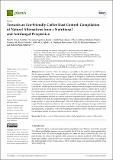Files in this item
Towards an eco-friendly coffee rust control : compilation of natural alternatives from a nutritional and antifungal perspective
Item metadata
| dc.contributor.author | Torres Castillo, Nora E. | |
| dc.contributor.author | Aguilera Acosta, Yovanina | |
| dc.contributor.author | Parra-Arroyo, Lizeth | |
| dc.contributor.author | Martínez-Prado , María-Adriana | |
| dc.contributor.author | Rivas Galindo, Verónica M. | |
| dc.contributor.author | Iqbal, Hafiz M. N. | |
| dc.contributor.author | Bonaccorso, A. Damiano | |
| dc.contributor.author | Melchor-Martínez , Elda M. | |
| dc.contributor.author | Parra-Saldivar, Roberto | |
| dc.date.accessioned | 2022-10-19T14:30:19Z | |
| dc.date.available | 2022-10-19T14:30:19Z | |
| dc.date.issued | 2022-10-17 | |
| dc.identifier | 281757018 | |
| dc.identifier | a78247b1-35fb-496d-ba7a-07ac54312bd8 | |
| dc.identifier | 85140727521 | |
| dc.identifier | 000875017000001 | |
| dc.identifier.citation | Torres Castillo , N E , Aguilera Acosta , Y , Parra-Arroyo , L , Martínez-Prado , M-A , Rivas Galindo , V M , Iqbal , H M N , Bonaccorso , A D , Melchor-Martínez , E M & Parra-Saldivar , R 2022 , ' Towards an eco-friendly coffee rust control : compilation of natural alternatives from a nutritional and antifungal perspective ' , Plants , vol. 11 , no. 20 , 2745 . https://doi.org/10.3390/plants11202745 | en |
| dc.identifier.issn | 2223-7747 | |
| dc.identifier.uri | https://hdl.handle.net/10023/26219 | |
| dc.description | Funding: CONACYT is acknowledged for partially supporting this work under Sistema Nacional de Investigadores (SNI) program awarded to Elda M. Melchor-Martínez (CVU: 230784), María Adriana Martínez-Prado (CVU: 85841), Verónica M. Rivas-Galindo (CVU: 22082), Hafiz M.N. Iqbal (CVU:735340) and Roberto Parra-Saldívar (CVU: 35753). Likewise, this work was partially supported by the National Council for Science and Technology of Mexico (CONACYT) and Tecnologico de Monterrey through the scholarship awarded to the first author (Nora E. Torres Castillo) (CVU: 968656) for the Ph.D. in Biotechnology program. | en |
| dc.description.abstract | Hemileia vastatrix (HV) is the pathogen responsible for the coffee leaf rust (CLR) disease that has spread globally. The condition causes losses of up to a billion dollars annually. It affects all types of crops regardless of their production regime (organic or inorganic). Approximately 80% of coffee is produced by smallholders in developing countries. Until the 90s, shaded-production systems and native varieties were encouraged; however, the rapid spread of CLR has forced farmers to migrate towards inorganic schemes, mainly due to a lack of knowledge about natural alternatives to pesticides that can be implemented to control HV. Therefore, the purpose of this article is to compile the currently existing options, emphasizing two key factors that guarantee efficient rust control: selective fungicidal activity against HV and the nutrition of coffee crops. Thus, by comprehending how these natural compounds (such as plant, bacteria, fungi, animals, or algae metabolites) impact coffee rust proliferation. Furthermore, since a various range of biochar effects contributes to the control of foliar fungal pathogens through modification of root exudates, soil properties, and nutrient availability, which influence the growth of antagonist microorganisms, we present a review of the pathogen-suppressive effects of biochar, and new control strategies suitable for organic schemes can be developed. | |
| dc.format.extent | 23 | |
| dc.format.extent | 998412 | |
| dc.language.iso | eng | |
| dc.relation.ispartof | Plants | en |
| dc.subject | Hemileia vastatrix | en |
| dc.subject | High mountain coffee | en |
| dc.subject | Shaded production systems | en |
| dc.subject | Coffea arabica | en |
| dc.subject | SB Plant culture | en |
| dc.subject | MCC | en |
| dc.subject.lcc | SB | en |
| dc.title | Towards an eco-friendly coffee rust control : compilation of natural alternatives from a nutritional and antifungal perspective | en |
| dc.type | Journal item | en |
| dc.contributor.institution | University of St Andrews. School of Chemistry | en |
| dc.contributor.institution | University of St Andrews. Institute of Behavioural and Neural Sciences | en |
| dc.identifier.doi | 10.3390/plants11202745 | |
| dc.description.status | Peer reviewed | en |
This item appears in the following Collection(s)
Items in the St Andrews Research Repository are protected by copyright, with all rights reserved, unless otherwise indicated.

